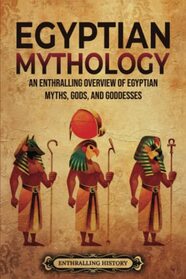Because there are more than 170-pages in this Egyptian Mythology text, I found this to be an extensive overview of ancient Egypt's many (over 1000) mythological figures of ancient Egypt. Since the earliest times, man has wondered how the world began and his place in that world. In other words, mythology explains ancient cultures' belief systems.
Although Egyptians had their creation myths, they honed in on the afterlife. They were deeply concerned with life after death. Their explanations and stories were extensive and powerful forces in their lives. In the oldest times, only the pharaohs were deemed significant enough to be concerned with an afterlife. Over the centuries, concern over an afterlife moved down through the priests, nobles, scribes, and others.
Part Two (of this four-part book) relates many mythological stories and legends. The full-color artwork adds much to understanding how the gods and creatures looked. The map, in the opening pages, was handy to readers. Part Three points out the major gods and goddesses; throughout this book, the author related the commonality of varying myths and gods across various cultures. The author shows how the Greeks adapted or absorbed gods/tales to enhance their worldview.
Of all the gods and goddesses outlined in this book, my favorite was Anubis. The Hall of Truth and the scale with the ostrich feather were fascinating reading. Over the generations, Anubis became more critical because he guarded the rites of the dead and made sure all found their justified place for eternity. Another fascinating tidbit was the high value the Egyptians had for cats.
Part Four explains how funerary rites evolved, and written texts changed. What became the "Coffin Texts" were collections of texts found in 19th-century excavations by archaeologists in Egypt. These were often spells and incantations to the gods. However, demons and traps abounded on the way, and people needed help to navigate the Duat until reaching paradise. Thus, the "Book of Two Ways" emerged -- a route by land and sea. These texts changed to the "Book of the Dead" -- arriving in the Middle and New Kingdoms. This text helped people overcome the dangers in the afterlife.
Like Noah and his Ark story, Egyptians have the "Book of the Heavenly Cow." First, man displeases the gods, and death ensues. Then, the gods create Ma'at, and humans must uphold it to earn eternal paradise. After the conclusion, there is an extensive bibliography for future study.
Although Egyptians had their creation myths, they honed in on the afterlife. They were deeply concerned with life after death. Their explanations and stories were extensive and powerful forces in their lives. In the oldest times, only the pharaohs were deemed significant enough to be concerned with an afterlife. Over the centuries, concern over an afterlife moved down through the priests, nobles, scribes, and others.
Part Two (of this four-part book) relates many mythological stories and legends. The full-color artwork adds much to understanding how the gods and creatures looked. The map, in the opening pages, was handy to readers. Part Three points out the major gods and goddesses; throughout this book, the author related the commonality of varying myths and gods across various cultures. The author shows how the Greeks adapted or absorbed gods/tales to enhance their worldview.
Of all the gods and goddesses outlined in this book, my favorite was Anubis. The Hall of Truth and the scale with the ostrich feather were fascinating reading. Over the generations, Anubis became more critical because he guarded the rites of the dead and made sure all found their justified place for eternity. Another fascinating tidbit was the high value the Egyptians had for cats.
Part Four explains how funerary rites evolved, and written texts changed. What became the "Coffin Texts" were collections of texts found in 19th-century excavations by archaeologists in Egypt. These were often spells and incantations to the gods. However, demons and traps abounded on the way, and people needed help to navigate the Duat until reaching paradise. Thus, the "Book of Two Ways" emerged -- a route by land and sea. These texts changed to the "Book of the Dead" -- arriving in the Middle and New Kingdoms. This text helped people overcome the dangers in the afterlife.
Like Noah and his Ark story, Egyptians have the "Book of the Heavenly Cow." First, man displeases the gods, and death ensues. Then, the gods create Ma'at, and humans must uphold it to earn eternal paradise. After the conclusion, there is an extensive bibliography for future study.




